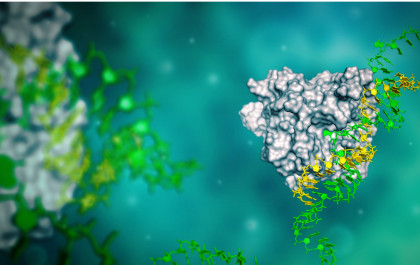ProQR Announces Publication on QR-110 for Leber’s Congenital Amaurosis 10 in the Journal Molecular Therapy - Nucleic Acids
LEIDEN, the Netherlands, Aug. 01, 2018 (GLOBE NEWSWIRE) -- ProQR Therapeutics N.V. (Nasdaq:PRQR), a company dedicated to changing lives through the creation of transformative RNA medicines for the treatment of severe genetic rare diseases, today announced the publication of a peer-reviewed manuscript describing the preclinical validation for the use of QR-110 in the treatment of Leber’s congenital amaurosis 10 (LCA10) in the journal Molecular Therapy - Nucleic Acids.
LCA10 is a severe inherited retinal dystrophy associated with mutations in the CEP290 gene. QR-110 is an RNA-based drug candidate that has the potential to restore sight or slow down the process of vision loss in patients with LCA10 by correcting the most common mutation causing LCA10, p.Cys998X. This mutation causes incorrect splicing of CEP290 mRNA.
This publication details the screening process by which QR-110 was identified as a potentially optimal therapeutic candidate using a patient-derived retinal organoid (“eye cup”) model. In additional in vitro testing, QR-110 demonstrated a dose-dependent restoration of mRNA and functional CEP290 protein while in vivo testing showed that QR-110 was well-tolerated following intravitreal injection. The results from this study suggest the pharmacodynamic, pharmacokinetic and safety properties make QR-110 a promising candidate for the treatment of LCA10. On the basis of the work detailed in this publication, QR-110 is currently being evaluated in a Phase 1/2 clinical trial in patients with LCA10.
“Given that the p.Cys998X mutation is a uniquely human mutation, there is no reliable in vivo model. Therefore, the eye cup model was essential in our preclinical validation process described in the paper,” said Peter Adamson, Ph.D., senior vice president of ophthalmology for ProQR. “The ongoing clinical trial of QR-110 in patients with LCA10 is evaluating the predictive accuracy of the model. If successful, we intend to use the platform to move our additional ophthalmology programs towards clinical development.”
About Leber’s Congenital Amaurosis 10
Leber’s congenital amaurosis (LCA) is the most common cause of blindness due to genetic disease in children and consists of a group of diseases of which LCA10 is one of the more severe forms. LCA10 is caused by mutations in the CEP290 gene, of which the p.Cys998X mutation is the most common. LCA10 leads to early loss of vision causing most people to lose their sight in the first few years of life. To date, there are no treatments approved or other products in clinical development that treat the underlying cause of the disease. Approximately 2,000 people in the Western world have LCA10 because of this mutation.
About QR-110
QR-110 is a first-in-class investigational RNA-based oligonucleotide designed to address the underlying cause of Leber’s congenital amaurosis 10 due to the p.Cys998X mutation in the CEP290 gene. The p.Cys998X mutation is a substitution of one nucleotide in the pre-mRNA that leads to aberrant splicing of the mRNA and non-functional CEP290 protein. QR-110 is designed to restore wild-type CEP290 mRNA leading to the production of wild-type CEP290 protein by binding to the mutated location in the pre-mRNA causing normal splicing of the pre-mRNA. QR-110 is intended to be administered through intravitreal injections in the eye and has been granted orphan drug designation in the United States and the European Union and fast track status by the FDA.
About ProQR
ProQR Therapeutics is dedicated to changing lives through the creation of transformative RNA medicines for the treatment of severe genetic rare diseases such as Leber’s congenital amaurosis 10, dystrophic epidermolysis bullosa and cystic fibrosis. Based on our unique proprietary RNA repair platform technologies we are growing our pipeline with patients and loved ones in mind.
*Since 2012*
FORWARD-LOOKING STATEMENTS
This press release contains forward-looking statements. All statements other than statements of historical fact are forward-looking statements, which are often indicated by terms such as “anticipate,” “believe,” “could,” “estimate,” “expect,” “goal,” “intend,” “look forward to”, “may,” “plan,” “potential,” “predict,” “project,” “should,” “will,” “would” and similar expressions. Forward-looking statements are based on management’s beliefs and assumptions and on information available to management only as of the date of this press release. These forward-looking statements include, but are not limited to, statements regarding QR-110 and its clinical development and therapeutic potential. Our actual results could differ materially from those anticipated in these forward-looking statements for many reasons, including, without limitation, risks associated with our clinical development activities, including that positive results observed in our prior and ongoing studies may not be replicated in later trials or guarantee approval of any product candidate by regulatory authorities, regulatory review or approval process, manufacturing processes and facilities, regulatory oversight, product commercialization, intellectual property claims, and the risks, uncertainties and other factors in our filings made with the Securities and Exchange Commission, including certain sections of our annual report filed on Form 20-F. Given these risks, uncertainties and other factors, you should not place undue reliance on these forward-looking statements, and we assume no obligation to update these forward-looking statements, even if new information becomes available in the future, except as required by law.
ProQR Therapeutics N.V.:
Smital Shah
Chief Financial Officer
T: +1 415 231 6431
ir@proqr.com


